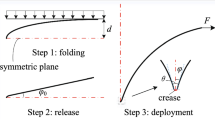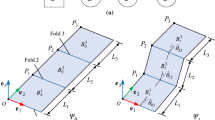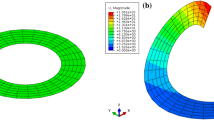Abstract
The dynamic modeling for the foldable origami space membrane structure considering contact-impact during the deployment is studied in this paper. The membrane is discretized using the triangular elements of the Absolute Nodal Coordinate Formulation (ANCF), and the stress–strain relationship of the membrane is determined based on the Stiffness Reduction Model (SRM). A mixed method is proposed for the frictionless contact problem by combining the membrane surface-to-surface (STS) contact elements with the membrane node-to-surface (NTS) contact elements to improve precision. Compared with the traditional STS contact elements, the mixed method can effectively avoid mutual penetration of the element boundaries, especially for the foldable origami membrane structures undergoing overall motions. The penalty method is adopted to enforce the nonpenetration condition. Moreover, special constraints are built for the fold lines, and then the dynamic equations of the membrane multibody system considering the damping effect are formulated. The dynamic deployment procedure of a leaf-in origami membrane structure with contact-impact is performed employing this present mixed method. The results demonstrate the effectiveness and superiority of the presented mixed method in the solution of the complicated contact problem, and the influence of the contact-impact on the dynamic performance is analyzed.
















Similar content being viewed by others
References
Liu, Z.-Q., Qiu, H., Li, X., Yang, S.-L.: Review of large spacecraft deployable membrane antenna structures. Chin. J. Mech. Eng. 30(6), 1447–1459 (2017)
Leipold, M., Eiden, M., Garner, C.E., Herbeck, L., Kassing, D., Niederstadt, T., Krüger, T., Pagel, G., Rezazad, M., Rozemeijer, H., Seboldt, W., Schöppinger, C., Sickinger, C., Unckenbold, W.: Solar sail technology development and demonstration. Acta Astronaut. 52(2), 317–326 (2003)
Peraza Hernandez, E.A., Hartl, D.J., Lagoudas, D.C.: Active Origami: Modeling, Design, and Applications. Springer, Cham (2018)
Seefeldt, P., Spietz, P., Spröwitz, T.: The preliminary design of the GOSSAMER-1 solar sail membrane and manufacturing strategies. In: Macdonald, M. (ed.) Advances in Solar Sailing, pp. 133–151. Springer, Berlin (2014)
Cai, J., Ren, Z., Ding, Y., Deng, X., Xu, Y., Feng, J.: Deployment simulation of foldable origami membrane structures. Aerosp. Sci. Technol. 67, 343–353 (2017)
De Focatiis, D.S.A., Guest, S.D.: Deployable membranes designed from folding tree leaves. Philos. Trans. R. Soc. Lond. A, Math. Phys. Eng. Sci. 360(1791), 227–238 (2002)
Nakano, T., Mori, O., Kawaguchi, J.I., Stability of spinning solar sail-craft containing a huge membrane. In: AIAA Guidance, Navigation, and Control Conference and Exhibit, San Francisco, California (2005)
Nishimaki, S.: Stability and control response of spinning solar sail-craft containing a huge membrane. In: 57th International Astronautical Congress, 2006, Valencia, Spain (2006)
Shirasawa, Y., Mori, O., Miyazaki, Y., Sakamoto, H., Hasome, M., Okuizumi, N., Sawada, H., Furuya, H., Matsunaga, S., Natori, M.: Analysis of membrane dynamics using multi-particle model for solar sail demonstrator” IKAROS”. In: 52nd AIAA/ASME/ASCE/AHS/ASC Structures, Structural Dynamics and Materials Conference, Denver, USA (2011)
Yan, X., Fu-ling, G.: Fold methods and deployment analysis of deployable membrane structure. Eng. Mech. 25(5), 176–181 (2008)
Shabana, A.A.: Review of past and recent developments. Multibody Syst. Dyn. 1(2), 189–222 (1997)
Shabana, A.A., Hussien, H.A., Escalona, J.L.: Application of the absolute nodal coordinate formulation to large rotation and large deformation problems. J. Mech. Des. 120(2), 188–195 (1998)
Dmitrochenko, O., Mikkola, A.: Two simple triangular plate elements based on the absolute nodal coordinate formulation. J. Comput. Nonlinear Dyn. 3(4), 041012 (2008)
Wong, Y.W., Pellegrino, S.: Wrinkled membranes. Part I: experiments. J. Mech. Mater. Struct. 1(1), 1–23 (2006)
Stein, M., Hedgepeth, J.M.: Analysis of partly wrinkled membranes. In: NASA TN D-813, pp. 1–23. National Aeronautics and Space Administration, Washington (1961)
Miyazaki, Y.: Dynamic analysis of deployable cable-membrane structures with slackening members. In: Proceedings of 21st International Symposium on Space Technology and Science, Omiya (1998)
Miyazaki, Y.: Wrinkle/slack model and finite element dynamics of membrane. Int. J. Numer. Methods Biomed. Eng. 66, 1179–1209 (2006)
Cannella, F., Dimperio, M., Canali, C., Rahman, N., Chen, F., Catelani, D., Caldwell, D.G., Dai, J.S.: Origami carton folding analysis using flexible panels. In: Advances in Reconfigurable Mechanisms and Robots II, Cham, pp. 95–106 (2016)
Liu, C., Tian, Q., Yan, D., Hu, H.: Dynamic analysis of membrane systems undergoing overall motions, large deformations and wrinkles via thin shell elements of ANCF. Comput. Methods Appl. Mech. Eng. 258, 81–95 (2013)
Miguel, E., Tamstorf, R., Bradley, D., Schvartzman, S.C., Thomaszewski, B., Bickel, B., Matusik, W., Marschner, S., Otaduy, M.A.: Modeling and estimation of internal friction in cloth. ACM Trans. Graph. 32(6), 212 (2013)
Zhu, T.: Contact/collision dynamics of space membrane structures described by Absolute Nodal Coordinate Formulation. In: The Chinese Congress of Theoretical and Applied Mechanics, Shanghai, China (2015)
Dmitrochenko, O.N., Pogorelov, D.Y.: Generalization of plate finite elements for absolute nodal coordinate formulation. Multibody Syst. Dyn. 10(1), 17–43 (2003)
Hammer, P.C., Stroud, A.H.: Numerical integration over simplexes and cones. Math. Tables Other Aids Comput. 10(55), 130–137 (1956)
Specht, B.: Modified shape functions for the three-node plate bending element passing the patch test. Int. J. Numer. Methods Biomed. Eng. 26(3), 705–715 (1988)
Zienkiewicz, O.C., Taylor, R.L.: The Finite Element Method, vol. 2. Butterworth, London (2000)
Zhao, J., Tian, Q., Hu, H.: Modal analysis of a rotating thin plate via absolute nodal coordinate formulation. J. Comput. Nonlinear Dyn. 6(4), 041013 (2011)
Konyukhov, A., Izi, R.: Introduction to Computational Contact Mechanics: A Geometrical Approach. Wiley Series in Computational Mechanics. Wiley, New York (2015)
Konyukhov, A., Schweizerhof, K.: Contact formulation via a velocity description allowing efficiency improvements in frictionless contact analysis. Comput. Mech. 33(3), 165–173 (2004)
Lee, J.W., Kim, H.W., Ku, H.C., Yoo, W.S.: Comparison of external damping models in a large deformation problem. J. Sound Vib. 325(4), 722–741 (2009)
Yoo, W.-S., Lee, J.-H., Park, S.-J., Sohn, J.-H., Dmitrochenko, O., Pogorelov, D.: Large oscillations of a thin cantilever beam: physical experiments and simulation using the absolute nodal coordinate formulation. Nonlinear Dyn. 34(1), 3–29 (2003)
Shi, J., Liu, Z., Hong, J.: Dynamic contact model of shell for multibody system applications. Multibody Syst. Dyn. 44(4), 335–366 (2018)
Macdonald, M.: Advances in Solar Sailing. Springer, Berlin (2014)
Acknowledgements
This research was supported by General Program (Nos. 11772186, 11772188) of the National Natural Science Foundation of China and the Key Program (No. 11932001) of the National Natural Science Foundation of China, for which the authors are grateful. This research was also supported by the Key Laboratory of Hydrodynamics (Ministry of Education).
Author information
Authors and Affiliations
Corresponding author
Additional information
Publisher’s Note
Springer Nature remains neutral with regard to jurisdictional claims in published maps and institutional affiliations.
Rights and permissions
About this article
Cite this article
Yuan, T., Liu, Z., Zhou, Y. et al. Dynamic modeling for foldable origami space membrane structure with contact-impact during deployment. Multibody Syst Dyn 50, 1–24 (2020). https://doi.org/10.1007/s11044-020-09737-x
Received:
Accepted:
Published:
Issue Date:
DOI: https://doi.org/10.1007/s11044-020-09737-x




